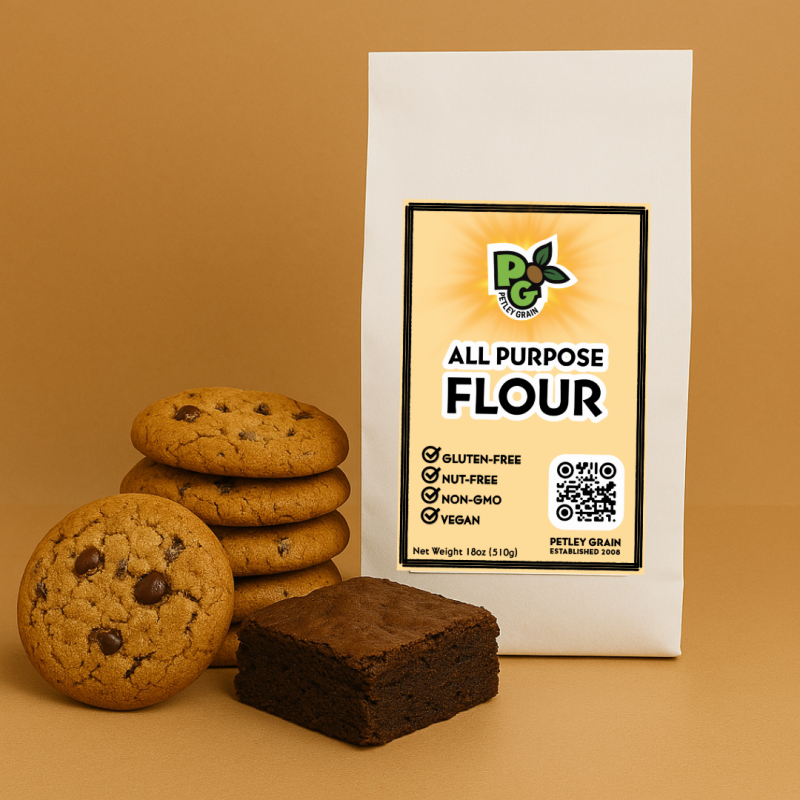
Here at Petley Grain, based in Newport News, Virginia, we're passionate about providing high-quality gluten-free flours directly to bakers like you. Through online interactions and feedback, we know many are navigating the unique world of gluten-free baking. One of the most common frustrations shared is texture – the dreaded crumbly cookie, the dense bread, the surprisingly dry cake. Often, the secret to overcoming these challenges lies in one crucial, frequently overlooked element: hydration.
Why Do Gluten-Free Doughs Need More Water?
The Thirst Factor
In traditional wheat baking, gluten proteins form an elastic network that traps water and air, creating structure and chew. When you remove gluten, you remove this network. Instead, water must be directly absorbed by the gluten-free flours, starches, and binders.
Think of it this way: gluten acts like a net holding water within the dough. Without it, the individual ingredients – the rice flour, sorghum flour, tapioca starch, and binders like psyllium husk (many of which are naturally quite 'thirsty') – need to soak up the water like tiny sponges.
If there isn't enough water:
- The flours and starches won't fully hydrate, leading to a gritty texture.
- Binders can't effectively create the gel-like structure needed to hold things together, resulting in crumbly bakes.
- The final product will likely be dense, dry, and stale much faster.
Proper hydration is essential for activating binders, allowing starches to gelatinize correctly during baking, improving rise, and ultimately creating a more pleasant, moist texture that lasts longer.

Not All Doughs Are Created Equal: Hydration By Bake Type
- The amount of hydration needed varies significantly depending on what you're making. A high-hydration bread dough would make disastrous cookies!
Gluten-Free Bread Doughs:
- Goal: Good structure, decent rise, moisture retention, relatively open crumb.
- Typical Hydration: Often much higher than conventional bread. Expect a very wet, sticky dough that often resembles a thick batter rather than something you can knead by hand.
- Why: High water content is vital for activating binders (especially psyllium husk) to create a network that mimics gluten, allowing the dough to rise and preventing a dense, brick-like loaf. It ensures the starches fully cook and contribute to a moist crumb.
Gluten-Free Cookie Doughs:
- Goal: Controlled spread, chewy or crisp texture, holding shape.
- Typical Hydration: Significantly lower than bread. Dough should be scoopable but not overly sticky or wet.
- Why: Too much water will cause excessive spreading, leading to thin, potentially burnt edges and a poor texture. Hydration needs careful balancing with the fats and sugars, which also play significant roles in spread and final texture.
Gluten-Free Cake & Muffin Batters:
- Goal: Tenderness, moisture, soft crumb.
- Typical Hydration: Often appears thinner than conventional wheat-based batters.
- Why: Sufficient liquid ensures the flours hydrate properly for a tender crumb, prevents dryness, and allows the chemical leaveners to work effectively.
Mastering Measurement & Adjustment: Practical Techniques
Getting hydration right involves precision and observation:
- Start with a Reliable Recipe: Use recipes specifically developed for gluten-free baking as your starting point.
- Measure Flour ACCURATELY: This is non-negotiable! Gluten-free flours vary greatly in density. Measuring by volume (cups) can lead to significant errors, throwing off your hydration ratio. Always use a kitchen scale to weigh your Petley Grain flours and other dry ingredients. It's the single best way to ensure consistency.
- Measure Liquids Precisely: Use standard liquid measuring cups for water, milk, etc.
- Embrace the Resting Period: Mix your dough or batter, then let it rest covered for 15-30 minutes (or as the recipe directs). This crucial step allows the thirsty GF flours and binders time to fully absorb the liquid. The mixture will noticeably thicken during this time. Don't assess the final consistency or add more liquid until after the rest!
- Learn Visual & Tactile Cues: Pay attention to recipe descriptions and photos (if available). Is the bread dough meant to be pourable? Scoopable? Learn what the target consistency looks like for different types of bakes.
- Adjust Incrementally (If Needed): After resting, if the dough seems significantly drier than described, add more liquid one tablespoon at a time, mixing thoroughly after each addition until you reach the desired consistency. It's easier to add more water than to correct an overly wet dough.
- Keep Notes: Your kitchen environment (humidity) and specific flour batches can have minor effects. Keep a baking journal noting the recipe, your measurements, resting time, and the results. This helps you replicate successes and learn from challenges
Hydration: The Key to Unlocking Texture
Mastering hydration might seem daunting initially, but understanding its critical role transforms your gluten-free baking. By recognizing why GF ingredients need more moisture, tailoring hydration to your specific bake, measuring accurately (especially your flours!), and utilizing resting times, you empower yourself to move beyond frustrating texture fails.
From our base in Newport News, Virginia, we're committed to sourcing and providing high-quality ingredients. When you start with carefully selected flours, like those from Petley Grain, and combine them with sound techniques like proper hydration, you unlock the door to truly delicious, wonderfully textured gluten-free breads, cookies, cakes, and more, delivered right to your kitchen.
Happy Baking from the team at Petley Grain!

Your Secret Ingredient for Unforgettable Bakes
If you’re craving chewy cookies, rich brownies, or tender scones — without the gluten — Petley Grain Gluten-Free Flour is made for moments like these.
We’ve spent years perfecting a flour blend that delivers the texture and taste your recipes deserve. No chalkiness. No off flavors. Just golden results.
Why Bakers Choose Petley Grain:
- Smooth, consistent texture in every batch
- No gums, no fillers — just honest ingredients
- Perfect for your favorite indulgent bakes
Ready to bake better?
Gluten-free doesn’t have to mean compromise.

Add comment
Comments